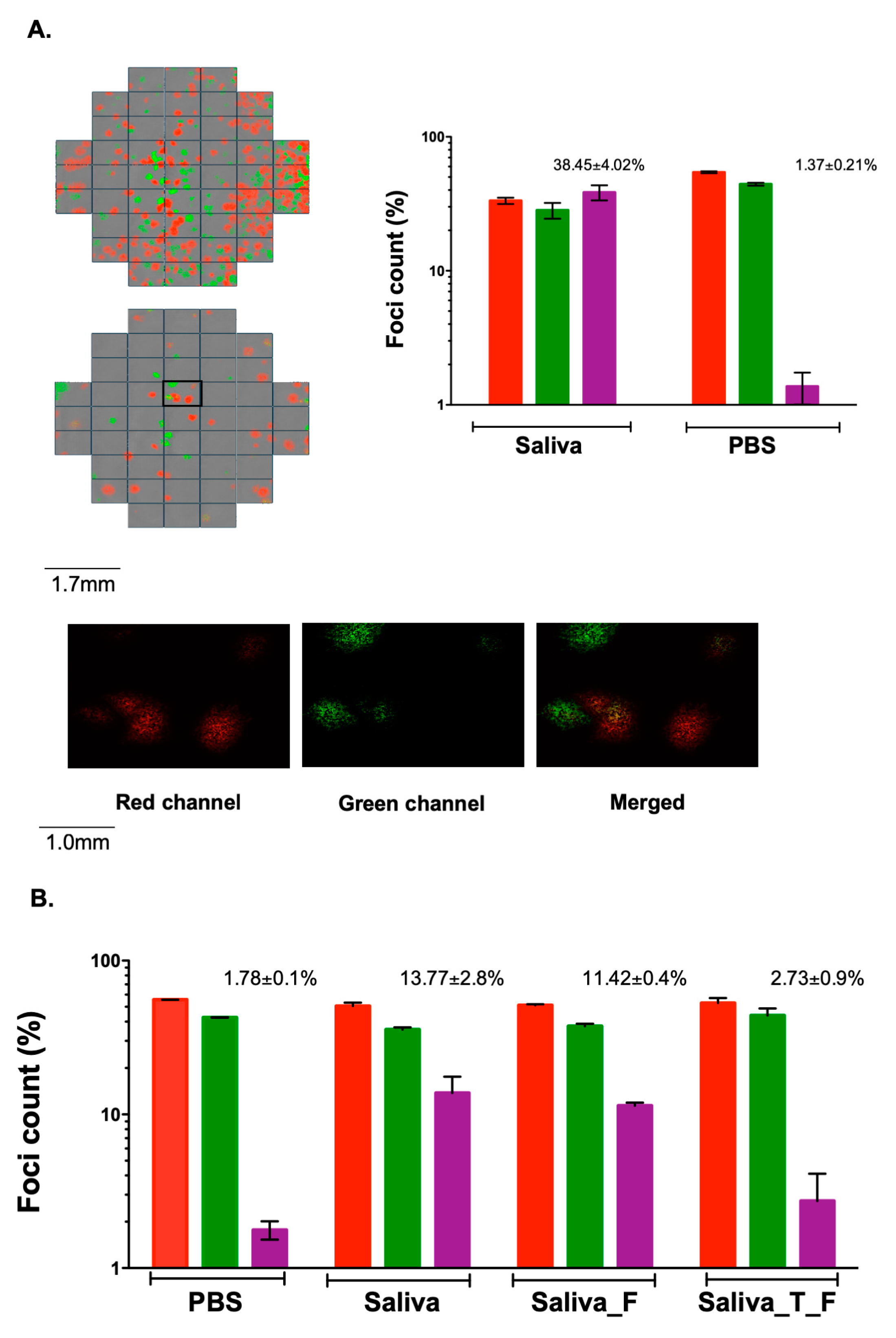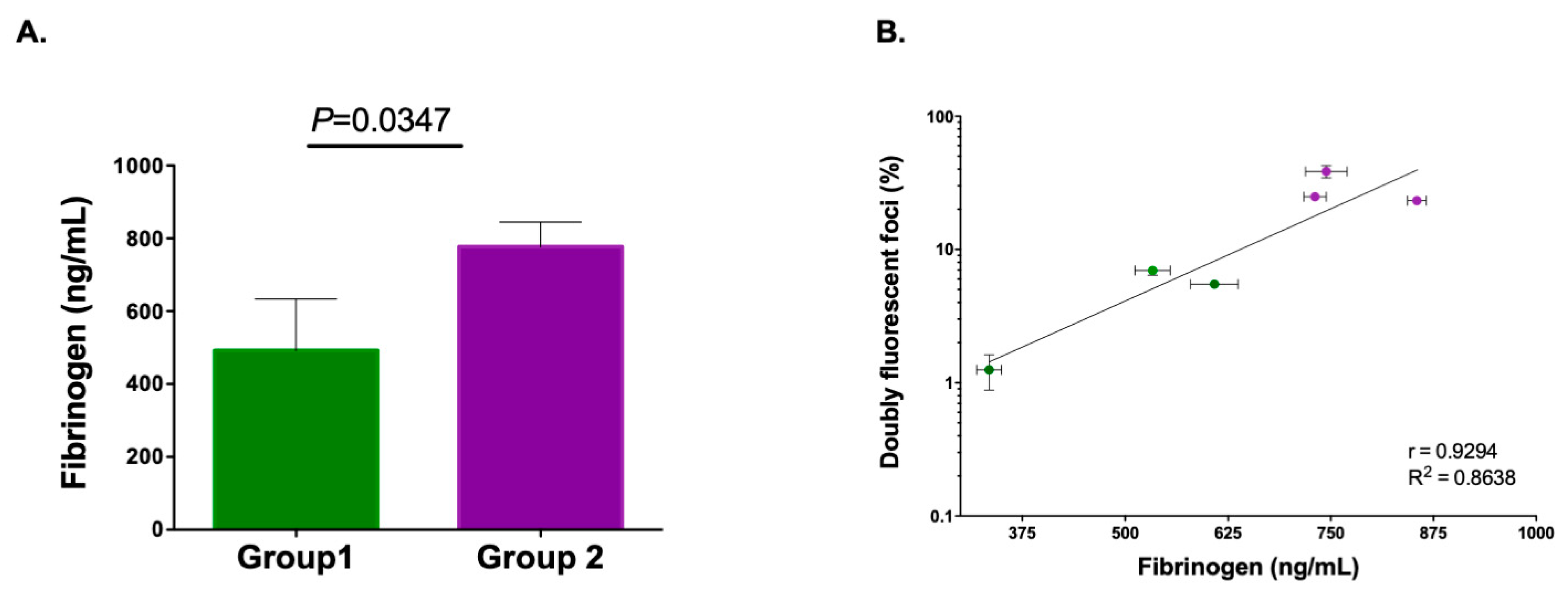Fibrinogen Gamma Chain Promotes Aggregation of Vesicular Stomatitis Virus in Saliva
Abstract
1. Introduction
2. Materials and Methods
2.1. Virus and Cells
2.2. Virion Purification
2.3. Virus Titration
2.4. Saliva Collection
2.5. Plasma and Serum Collection
2.6. Automated Fluorescence Microscopy
2.7. Flow Cytometry Co-Fluorescence Assay
2.8. Probabilistic Model for Inferring the Fraction of Infectious Particles in Aggregates
2.9. Reduction, Alkylation, and Digestion of Saliva Samples
2.10. LC-MS/MS
2.11. ELISA
3. Results
3.1. VSV Aggregation is Promoted by Human Saliva in a Variable and Protein-Dependent Manner
3.2. Identification of Differentially Expressed Saliva Proteins Associated to VSV Aggregation
3.3. Experimental Validation of VSV Aggregation
4. Discussion
Supplementary Materials
Author Contributions
Funding
Acknowledgments
Conflicts of Interest
References
- Sanjuán, R. Collective properties of viral infectivity. Curr. Opin. Virol. 2018, 33, 1–6. [Google Scholar] [CrossRef] [PubMed]
- Leeks, A.; Sanjuán, R.; West, S.A. The evolution of collective infectious units in viruses. Virus Res. 2019, 265, 94–101. [Google Scholar] [CrossRef] [PubMed]
- Feng, Z.; Hensley, L.; McKnight, K.L.; Hu, F.; Madden, V.; Ping, L.; Jeong, S.H.; Walker, C.; Lanford, R.E.; Lemon, S.M. A pathogenic picornavirus acquires an envelope by hijacking cellular membranes. Nature 2013, 496, 367–371. [Google Scholar] [CrossRef] [PubMed]
- Altan-Bonnet, N.; Chen, Y.-H. Intercellular transmission of viral populations with vesicles. J. Virol. 2015, 89, JVI.01452-15. [Google Scholar] [CrossRef]
- Arantes, T.S.; Rodrigues, R.A.L.; dos Santos Silva, L.K.; Oliveira, G.P.; de Souza, H.L.; Khalil, J.Y.B.; de Oliveira, D.B.; Torres, A.A.; da Silva, L.L.; Colson, P.; et al. The large marseillevirus explores different entry pathways by forming giant infectious vesicles. J. Virol. 2016, 90, 5246–5255. [Google Scholar] [CrossRef]
- Robinson, C.M.; Jesudhasan, P.R.; Pfeiffer, J.K. Bacterial lipopolysaccharide binding enhances virion stability and promotes environmental fitness of an enteric virus. Cell Host Microbe 2014, 15, 36–46. [Google Scholar] [CrossRef]
- Santiana, M.; Ghosh, S.; Ho, B.A.; Rajasekaran, V.; Du, W.L.; Mutsafi, Y.; De Jésus-Diaz, D.A.; Sosnovtsev, S.V.; Levenson, E.A.; Parra, G.I.; et al. Vesicle-cloaked virus clusters are optimal units for inter-organismal viral transmission. Cell Host Microbe 2018, 24, 208–220. [Google Scholar] [CrossRef]
- Slack, J.; Arif, B.M. The baculoviruses occlusion-derived virus: Virion structure and function. Adv. Virus Res. 2006, 69, 99–165. [Google Scholar]
- Shapiro, A.; Green, T.; Rao, S.; White, S.; Carner, G.; Mertens, P.P.C.; Becnel, J.J. Morphological and molecular characterization of a cypovirus (Reoviridae) from the mosquito Uranotaenia sapphirina (Diptera: Culicidae). J. Virol. 2005, 79, 9430–9438. [Google Scholar] [CrossRef]
- Gerba, C.P.; Betancourt, W.Q. Viral Aggregation: Impact on virus behavior in the environment. Environ. Sci. Technol. 2017, 51, 7318–7325. [Google Scholar] [CrossRef]
- Mattle, M.J.; Crouzy, B.; Brennecke, M.R.; Wigginton, K.; Perona, P.; Kohn, T. Impact of virus aggregation on inactivation by peracetic acid and implications for other disinfectants. Environ. Sci. Technol. 2011, 45, 7710–7717. [Google Scholar] [CrossRef]
- Cuevas, J.M.; Durán-Moreno, M.; Sanjuán, R. Multi-virion infectious units arise from free viral particles in an enveloped virus. Nat. Microbiol. 2017, 2, 1–7. [Google Scholar] [CrossRef] [PubMed]
- Scherer, C.F.C.; O’Donnell, V.; Golde, W.T.; Gregg, D.; Estes, D.M.; Rodriguez, L.L. Vesicular stomatitis New Jersey virus (VSNJV) infects keratinocytes and is restricted to lesion sites and local lymph nodes in the bovine, a natural host. Vet. Res. 2007, 38, 375–390. [Google Scholar] [CrossRef] [PubMed]
- Smith, P.F.; Howerth, E.W.; Carter, D.; Gray, E.W.; Noblet, R.; Berghaus, R.D.; Stallknecht, D.E.; Mead, D.G. Host predilection and transmissibility of vesicular stomatitis New Jersey virus strains in domestic cattle (Bos taurus) and swine (Sus scrofa). BMC Vet. Res. 2012, 8, 1–9. [Google Scholar] [CrossRef] [PubMed]
- Smith, P.F.; Howerth, E.W.; Carter, D.; Gray, E.W.; Noblet, R.; Mead, D.G. Mechanical transmission of vesicular stomatitis New Jersey virus by Simulium vittatum (diptera: Simuliidae) to domestic swine (Sus scrofa). J. Med. Entomol. 2009, 46, 1537–1540. [Google Scholar] [CrossRef]
- Asai, D.; Nakashima, H. Pathogenic viruses commonly present in the oral cavity and relevant antiviral compounds derived from natural products. Medicines 2018, 5, 120. [Google Scholar] [CrossRef]
- Välimaa, H.; Waris, M.; Hukkanen, V.; Blankenvoorde, M.F.J.; Nieuw Amerongen, A.V.; Tenovuo, J. Salivary defense factors in herpes simplex virus infection. J. Dent. Res. 2002, 81, 416–421. [Google Scholar] [CrossRef]
- Huynh, G.T.; Rong, L. Modeling the dynamics of virus shedding into the saliva of epstein-barr virus positive individuals. J. Theor. Biol. 2012, 310, 105–114. [Google Scholar] [CrossRef]
- Stowell, J.D.; Forlin-Passoni, D.; Radford, K.; Bate, S.L.; Dollard, S.C.; Bialek, S.R.; Cannon, M.J.; Schmid, D.S. Cytomegalovirus survival and transferability and the effectiveness of common hand-washing agents against cytomegalovirus on live human hands. Appl. Environ. Microbiol. 2014, 80, 455–461. [Google Scholar] [CrossRef]
- Zheng, C.; Nikolov, N.P.; Alevizos, I.; Cotrim, A.P.; Liu, S.; McCullagh, L.; Chiorini, J.A.; Illei, G.G.; Baum, B.J. Transient detection of E1-containing adenovirus in saliva after the delivery of a first-generation adenoviral vector to human parotid gland. J. Gene Med. 2010, 12, 3–10. [Google Scholar] [CrossRef][Green Version]
- Andreu-Moreno, I.; Sanjuán, R. Collective infection of cells by viral aggregates promotes early viral proliferation and reveals a cellular-level allee effect. Curr. Biol. 2018, 28, 3212–3219. [Google Scholar] [CrossRef] [PubMed]
- Tyanova, S.; Temu, T.; Cox, J. The MaxQuant computational platform for mass spectrometry-based shotgun proteomics. Nat. Protoc. 2016, 11, 2301–2319. [Google Scholar] [CrossRef] [PubMed]
- Tyanova, S.; Temu, T.; Sinitcyn, P.; Carlson, A.; Hein, M.Y.; Geiger, T.; Mann, M.; Cox, J. The Perseus computational platform for comprehensive analysis of (prote)omics data. Nat. Methods 2016, 13, 731–740. [Google Scholar] [CrossRef] [PubMed]
- Asselta, R.; Duga, S.; Tenchini, M.L. The molecular basis of quantitative fibrinogen disorders. J. Thromb. Haemost. 2006, 4, 2115–2129. [Google Scholar] [CrossRef] [PubMed]
- Qiu, L.L.; Levinson, S.S.; Keeling, K.L.; Elin, R.J. Convenient and effective method for removing fibrinogen from serum specimens before protein electrophoresis. Clin. Chem. 2003, 49, 868–872. [Google Scholar] [CrossRef]
- Asselta, R.; Robusto, M.; Braidotti, P.; Peyvandi, F.; Nastasio, S.; D’Antiga, L.; Perisic, V.N.; Maggiore, G.; Caccia, S.; Duga, S. Hepatic fibrinogen storage disease: Identification of two novel mutations (p.Asp316Asn, fibrinogen Pisa and p.Gly366Ser, fibrinogen beograd) impacting on the fibrinogen γ-module. J. Thromb. Haemost. 2015, 13, 1459–1467. [Google Scholar] [CrossRef]
- Hanington, P.C.; Zhang, S.M. The primary role of fibrinogen-related proteins in invertebrates is defense, not coagulation. J. Innate Immun. 2011, 3, 17–27. [Google Scholar] [CrossRef]
- Joo, S.J. Mechanisms of platelet activation and integrin αIIβ3. Korean Circ. J. 2012, 42, 295–301. [Google Scholar] [CrossRef]
- Nieswandt, B.; Varga-Szabo, D.; Elvers, M. Integrins in platelet activation. J. Thromb. Haemost. 2009, 7, 206–209. [Google Scholar] [CrossRef]
- Ma, Y.Q.; Qin, J.; Plow, E.F. Platelet integrin alpha(IIb)beta(3): Activation mechanisms. Blood 2014, 5, 1345–1352. [Google Scholar]
- Sahni, A.; Guo, M.; Sahni, S.K.; Francis, C.W. Interleukin-1β but not IL-1α binds to fibrinogen and fibrin and has enhanced activity in the bound form. Blood 2004, 15, 409–414. [Google Scholar] [CrossRef]
- Rivera, J.; Vannakambadi, G.; Höök, M.; Speziale, P. Fibrinogen-binding proteins of gram-positive bacteria. Thromb. Haemost. 2007, 98, 503–511. [Google Scholar] [PubMed]
- Thomas, S.; Liu, W.; Arora, S.; Ganesh, V.; Ko, Y.-P.; Höök, M. The complex fibrinogen interactions of the Staphylococcus aureus coagulases. Front. Cell. Infect. Microbiol. 2019, 9, 1–11. [Google Scholar] [CrossRef]
- Happonen, L.; Hauri, S.; Svensson Birkedal, G.; Karlsson, C.; de Neergaard, T.; Khakzad, H.; Nordenfelt, P.; Wikström, M.; Wisniewska, M.; Björck, L.; et al. A quantitative Streptococcus pyogenes–human protein–protein interaction map reveals localization of opsonizing antibodies. Nat. Commun. 2019, 10, 1–15. [Google Scholar] [CrossRef]
- Finkelshtein, D.; Werman, A.; Novick, D.; Barak, S.; Rubinstein, M. LDL receptor and its family members serve as the cellular receptors for vesicular stomatitis virus. Proc. Natl. Acad. Sci. 2013, 110, 7306–7311. [Google Scholar] [CrossRef] [PubMed]
- Hall, M.P.; Burson, K.K.; Huestis, W.H. Interactions of a vesicular stomatitis virus G protein fragment with phosphatidylserine: NMR and fluorescence studies. Biochim. Biophys. Acta - Biomembr. 1998, 1415, 101–113. [Google Scholar] [CrossRef][Green Version]
- Moerdyk-Schauwecker, M.; Hwang, S.I.; Grdzelishvili, V.Z. Cellular proteins associated with the interior and exterior of vesicular stomatitis virus virions. PLoS One 2014, 9, e104688. [Google Scholar] [CrossRef]
- Snel, B.; Lehmann, G.; Bork, P.; Huynen, M.A. STRING: A web-server to retrieve and display the repeatedly occurring neighbourhood of a gene. Nucleic Acids Res. 2000, 28, 3442–3444. [Google Scholar] [CrossRef]
- Makogonenko, E.; Tsurupa, G.; Ingham, K.; Medved, L. Interaction of fibrin(ogen) with fibronectin: Further characterization and localization of the fibronectin-binding site. Biochemistry 2002, 41, 7907–7913. [Google Scholar] [CrossRef]




| Donor | Saliva Incubation | PBS Control | t-Test p-Value | Salivary pH | Gender | Age |
|---|---|---|---|---|---|---|
| P11 | 6.91 ± 0.61 | 0.64 ± 0.08 | < 0.001 | 6.4 | F | 32 |
| P2 | 10.03 ± 0.73 | 0.26 ± 0.26 | < 0.001 | 7.4 | F | 24 |
| P3 | 11.82 ± 0.62 | 0.63 ± 0.32 | < 0.001 | 7.3 | M | 25 |
| P4 | 19.79 ± 1.92 | 2.87 ± 0.34 | < 0.001 | 7.2 | M | 31 |
| P52 | 23.92 ± 0.74 | 0.95 ± 0.17 | < 0.001 | 7.4 | M | 25 |
| P6 | 38.46 ± 2.84 | 1.38 ± 0.21 | < 0.001 | 7.0 | F | 27 |
| P7 | 1.26 ± 0.38 | 0.34 ± 0.09 | 0.0764 | 6.4 | M | 22 |
| P8 | 23.23 ± 1.23 | 1.65 ± 0.89 | < 0.001 | 6.5 | F | 24 |
| P9 | 20.85 ± 0.05 | 0.93 ± 0.14 | < 0.001 | 7.2 | F | 34 |
| P10 | 24.84 ± 1.76 | 1.23 ± 0.17 | < 0.001 | 6.4 | F | 33 |
| P11 | 6.96 ± 0.54 | 1.57 ± 0.25 | < 0.001 | 7.0 | M | 40 |
| P12 | 13.89 ± 1.02 | 0.79 ± 0.18 | < 0.001 | 7.0 | M | 39 |
| P13 | 5.37 ± 0.37 | 1.61 ± 0.06 | < 0.001 | 6.0 | F | 37 |
| Donor | Serum | Plasma |
|---|---|---|
| 1 | 2.46 ± 0.01 | 8.19 ± 0.01 |
| 2 | 1.85 ± 0.01 | 25.86 ± 0.02 |
| 3 | 1.79 ± 0.01 | 24.09 ± 0.02 |
© 2020 by the authors. Licensee MDPI, Basel, Switzerland. This article is an open access article distributed under the terms and conditions of the Creative Commons Attribution (CC BY) license (http://creativecommons.org/licenses/by/4.0/).
Share and Cite
Anschau, V.; Sanjuán, R. Fibrinogen Gamma Chain Promotes Aggregation of Vesicular Stomatitis Virus in Saliva. Viruses 2020, 12, 282. https://doi.org/10.3390/v12030282
Anschau V, Sanjuán R. Fibrinogen Gamma Chain Promotes Aggregation of Vesicular Stomatitis Virus in Saliva. Viruses. 2020; 12(3):282. https://doi.org/10.3390/v12030282
Chicago/Turabian StyleAnschau, Valesca, and Rafael Sanjuán. 2020. "Fibrinogen Gamma Chain Promotes Aggregation of Vesicular Stomatitis Virus in Saliva" Viruses 12, no. 3: 282. https://doi.org/10.3390/v12030282
APA StyleAnschau, V., & Sanjuán, R. (2020). Fibrinogen Gamma Chain Promotes Aggregation of Vesicular Stomatitis Virus in Saliva. Viruses, 12(3), 282. https://doi.org/10.3390/v12030282






